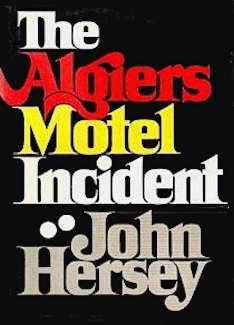





by John Hersey

Reviewed by Theresa Welsh
|
This book, written over forty years ago, brought back powerful memories for me... memories of an apartment in Detroit and turmoil outside and 22-year-old me and my new husband inside, listening to gunshots and watching tanks with men with guns inside roll down the street, and being afraid. The year was 1967 and the Detroit riot was in full swing and I was in the middle of it. THE NOTORIOUS ALGIERS MOTELInside a notorious motel on Woodward Avenue, three young black men ended up dead after Detroit police and National Guardsmen stormed inside and searched for snipers who, it turned out, did not exist. I remember the neon palm trees on the big gaudy sign in front of the Algiers Motel, a place now gone and turned into a greenway with a winding path, nothing left of a day in July of 1967 when an odd collection of young black men and two white girls who were runaways were terrorized inside as the whole city was wrapped in fear and confusion. A FAMOUS AUTHOR, SHOCKING LESSONSJohn Hersey, author of wonderful books, came to Detroit after the incident to write about it. What he found in meticulous efforts to discover how these young men died, clearly left him shaken. He departed from any normal format for a book about a crime by using long passages of the witnesses' own words and by injecting himself in the narrative from time to time and by piecing together short quotes by various parties involved in the incident to try to establish timelines. As a skilled author, Hersey knew this was a non-standard format, but he chose it, I think, in order to highlight the horror as felt by the victims. He did not claim to be "objective," but rather wanted to give the reader a look inside the world of a segregated society, of those who both participated in the riot and also became its victims, and of the policemen who thought they were doing their job. The Algiers Motel Incident was just one part of an event that left 43 people dead, and, as an article in the Detroit Free Press after the riot pointed out, most of those were avoidable deaths of innocent people who got in the way of bullets fired by police or National Guardsmen. Some of the dead were looters and only one death was a policeman. When order breaks down and people take to the street, breaking store windows and setting fires, the chaos of the situation makes it difficult to sort out who did what. But our intrepid author worked hard at gaining the trust of the black families whose members were involved in this incident. He found people who were deeply suspicious of the police, who felt they were harassed and never given a fair break. He must have gone through many cassette tapes recording their exact words (there were no digital recorders in 1967). SNIPERS ACROSS THE STREETA black private cop who was guarding an insurance building across from the motel heard what he thought were gunshots coming from the motel. He called his superior who notified the police who apparently notified the National Guard. The National Guard were well-armed, as I knew personally because they parked their tanks right around the block from my apartment at West Chicago and Linwood. The army had also been sent by President Lyndon Johnson and they were headquartered on the East Side. The army was much better trained and led than the Guardsmen and there were fewer deaths on the East Side. There was a great deal of hysteria over the possibility of snipers shooting from windows and randomly killing people. That's what the law enforcement men who showed up at the Algiers Motel thought was going on. But apparently, there was no sniper, although there was a device that made gunshot noises (a "starter" pistol) as Hersey was able to coax out of his interviews with survivors. There were two white girls and some young black males in the various rooms of the motel "annex," which was a large house facing Virginia Park street that was owned by the motel. These were actually small apartments that were rented for extended times or some just by the night. The motel was known to be a place where prostitution, drugs and gambling took place. A HARSH RESPONSEThe book highlights the actions of three white Detroit police officers who were there and the three young men who were killed. The young men in the building were rounded up and made to face the wall in the downstairs hallway, as were the two girls. The two girls were treated roughly and their clothes were pulled off. The young men were repeatedly beaten as the police demanded to know where the gun was. When the Guardsmen arrived, the two girls were wearing only panties and there was a dead body in one room. In a cruel "game," the young black men, told they would be killed, were taken one by one into different rooms and shots were heard in the hallway. This was to "frighten" the others into giving up the alleged gun, but they were not actually shot. As least not until one of the cops asked another cop if he wanted to kill one and no one told him it was a game. The cop took Aubury Pollard, who had already been beaten mercilessly, into a room and fired his gun. The young man lay dead on the floor. A MOTHER'S GRIEFThe author talked to the mothers and fathers and brothers of the victims, and the anguish of victim Auburey Pollard's mother is one of the most heartfelt parts of the book. Here was a woman whose son had been murdered by a policeman for no good reason, who had other sons, one of whom was given a three year jail sentence for stealing $7 (which the author, when he interviewed the young man in jail found he did not actually do), another was in detention for 15 days for driving without a license, and another son was serving as a soldier in Viet Nam and suffering with mental problems. The effect of all that left this mother's home shattered, her husband too full of rage for her to live with, her sons with a deep sense of unfairness and anger. Her words are heartbreaking to read. JUSTICE DENIED?There were legal proceedings brought against the policemen, but they went nowhere. The three officers featured in the book all lost their jobs, but charges against two of them were dismissed right away and the other was turned loose on bond. At a trial for the third officer, the judge ruled that the witnesses (the young men who had not been shot, but witnessed it, as well as the two white girls) were all unreliable and their testimony could not be believed. None of the cops expressed any regret for what they had done and all ended up with new good-paying jobs. JUSTICE STILL DENIED, EVEN TODAY?Events in 2014 in Ferguson Missouri sound all too much like the events in this book, and that too is startling to me. Race relations in Detroit were obviously poor in 1967 and the city had a long history of segregation and racial violence. But we've seen a lot more integration since then and many black people in good jobs (including the Top Job, President of the United States). So how could anything resembling what happened at the Algiers Motel in 1967 happen today? In Detroit in 1967, the police Department was mostly white and that is true too of Ferguson. In Detroit in 1967, the black population did not trust the police or the criminal justice system (with justification, considering what happened). That appears to be true in 2014 in Ferguson. In both cases, the response from the city has been to acquire more military-type "riot control" equipment. I had to think about how I felt, reading this book which I had long put off reading, but doing so while events were unfolding in Ferguson on the nightly news. I started thinking about how, back in the old days, I thought black people had an exaggerated idea of how well white people lived compared to themselves. It might have been those 1960s TV shows where white people all lived in better-than-average houses that made many black people think all white people lived the good life, with expensive furnishings, clothes and cars and good jobs handed to them. I knew that wasn't true, that white people too could be poor and had to struggle to get ahead, as I had struggled. But it occurred to me that I DID have something that black people in Detroit in 1967 did not have: a white face. Just by being white I was not subject to the harassment and negative stereotype that followed black people everywhere. And, despite lots of changes in American society, black people still feel that harassment and stereotyping. The story in this book might be about something that happened over forty years ago, but the story does not seem to change. Have we truly learned anything in the years since three young men were shot dead in a motel in Detroit in 1967? ~ See my web page, Detroit's Segregation Past. ~ Buy The Algiers Motel Incident ~ Read my ebook, A Guide to Post-Industrial Detroit for information on historic sites in Detroit. See book description. ~ Check out my Detroit photo essay web pages. Other Books of InterestFor a great book about an earlier incident involving a black doctor, Dr. Ossian Sweet, whose move into a white neighborhood in the 1920s sparked violence that led to a famous trial with Clarence Darrow hired by the NAACP for the defense. The fascinating story is in Arc of Justice by Kevin Boyle, available from amazon.com. See my review of the book and click here for its amazon page: Arc of Justice: A Saga of Race, Civil Rights, and Murder in the Jazz Age I've also reviewed another book written by the son of a white Detroit cop about growing up white in a mostly black city, Made in Detroit by Paul Clemons. Read my review. Also see my review of Hard Stuff: The Autobiography of Coleman Young, Detroit's first black mayor. Young knew Dr. Sweet, for whom he did errands when he was growing up in Black Bottom, the near East Side neighborhood where blacks lived before the neighborhood was bulldozed to build the Chrysler freeway and Lafayette Park. |
Books about the |
 |
 |